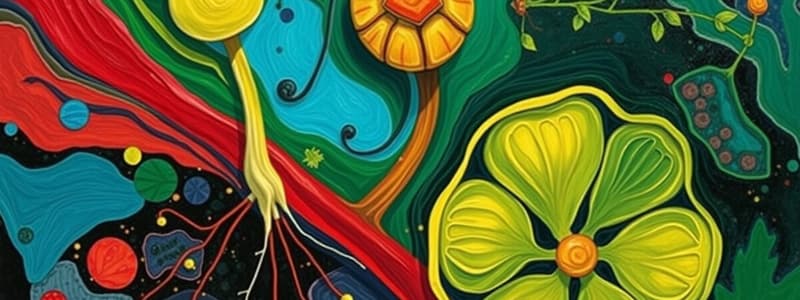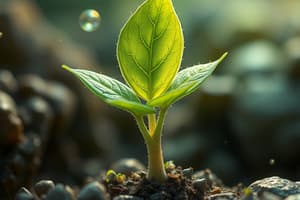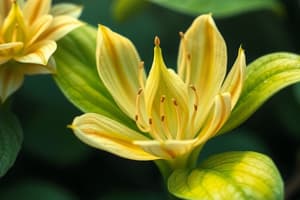Podcast
Questions and Answers
What type of special stem does the ginger plant have?
What type of special stem does the ginger plant have?
- Tuber
- Rhizome (correct)
- Stolon
- Scion
A strawberry is considered a simple fruit.
A strawberry is considered a simple fruit.
False (B)
What explains why high salt content in soil can kill plants?
What explains why high salt content in soil can kill plants?
Osmosis pulls water out of the roots.
The vascular cambium produces _____ and _____, which are in the wood and bark.
The vascular cambium produces _____ and _____, which are in the wood and bark.
Match the following types of flowers with their characteristics:
Match the following types of flowers with their characteristics:
What is the primary characteristic of a nut?
What is the primary characteristic of a nut?
A berry consists of an outer fleshy layer and an inner papery core.
A berry consists of an outer fleshy layer and an inner papery core.
What is the term for the period of inactivity that occurs before germination?
What is the term for the period of inactivity that occurs before germination?
The tiny, tube-like projections that absorb water and minerals from the soil are called __________.
The tiny, tube-like projections that absorb water and minerals from the soil are called __________.
Match the following plant structures with their functions:
Match the following plant structures with their functions:
Which process involves the mixing of substances through random molecular motion?
Which process involves the mixing of substances through random molecular motion?
Self-pollination occurs when flowers develop underground and cannot be pollinated by other flowers.
Self-pollination occurs when flowers develop underground and cannot be pollinated by other flowers.
What type of reproduction involves the union of sperm and egg cells?
What type of reproduction involves the union of sperm and egg cells?
What is the process called when a new plant grows from a root, stem, or leaf of an existing plant?
What is the process called when a new plant grows from a root, stem, or leaf of an existing plant?
An anther is the part of a flower that produces pollen.
An anther is the part of a flower that produces pollen.
What are the small openings in a stem's bark that allow air to enter?
What are the small openings in a stem's bark that allow air to enter?
The tough outer covering of a herbaceous monocot stem is called the _______.
The tough outer covering of a herbaceous monocot stem is called the _______.
Which of the following is NOT a plant hormone?
Which of the following is NOT a plant hormone?
What part of a seed's embryo develops into the new plant's root system?
What part of a seed's embryo develops into the new plant's root system?
Match the following plant structures with their descriptions:
Match the following plant structures with their descriptions:
What is the chief factor determining when a plant flowers?
What is the chief factor determining when a plant flowers?
Flashcards are hidden until you start studying
Study Notes
Plant Structures and Functions
- Lenticels are small openings in a stem's bark that facilitate air exchange.
- Vegetative reproduction involves a new plant emerging from a root, stem, or leaf of an existing plant.
- The chief factor that determines when a plant flowers is the length of day and night.
- Sepals protect the rest of the flower during its development.
- The rind refers to the tough outer covering of a herbaceous monocot stem.
Plant Growth and Germination
- The first step in germination occurs when the seed begins to absorb water.
- Anthers produce pollen, which is essential for plant reproduction.
- The radicle is the part of a seed's embryo that develops into the root system of the new plant.
- Factors affecting sap movement include transpiration pull, root pressure, and capillarity.
Reproductive Structures and Processes
- Adventitious roots grow from unusual regions of a plant, aiding in support and nutrient uptake.
- Endosperm surrounds and nourishes a developing plant embryo.
- Gametes are reproductive cells, including egg and sperm cells.
- The cortex of a root is involved in food storage.
Plant Physiology and Seed Dispersal
- Diffusion is the process of substance mixing through random molecular motion.
- The internode is the section of a twig located between nodes.
- Dandelion seed dispersal by wind exemplifies natural seed movement mechanisms.
- The elongation region of a root tip is where cells increase in size, facilitating root growth.
Plant Responses and Fruit Types
- Self-pollination occurs in certain grasses where flowers are pollinated underground.
- Phototropism is demonstrated when seedlings bend toward a light source.
- Aggregate fruits, like strawberries, develop from a single flower with multiple pistils.
Reproductive Strategies in Plants
- The period of dormancy precedes germination, during which seeds remain inactive.
- Xylem tissue, commonly called wood, supports the plant structure.
- Sexual reproduction in plants involves the uniting of sperm and egg cells.
Root Structures and Water Absorption
- The root cap protects the tender tip of the root, allowing safe growth through the soil.
- Root hairs are tiny projections from epidermal cells that enhance water and mineral absorption.
Fertilization and Growth Support
- After pollination, the formation of a pollen tube marks the initial step in fertilization.
- Cotyledons provide energy for the initial sprouting of a plant.
- High salt concentrations in soil can cause osmotic pressure, leading to dehydration of roots and plant death.
Types of Woody Stems and Flower Categories
- The vascular cambium is the layer that produces xylem and phloem, positioned between bark and wood for nutrient transport.
- Rhizomes are underground stems, like those of ginger, from which new plants can grow horizontally.
- Incomplete flowers, such as those examined in grass plants, lack petals but can have stamens and pistils, often classified by the presence of bracts.
Studying That Suits You
Use AI to generate personalized quizzes and flashcards to suit your learning preferences.



